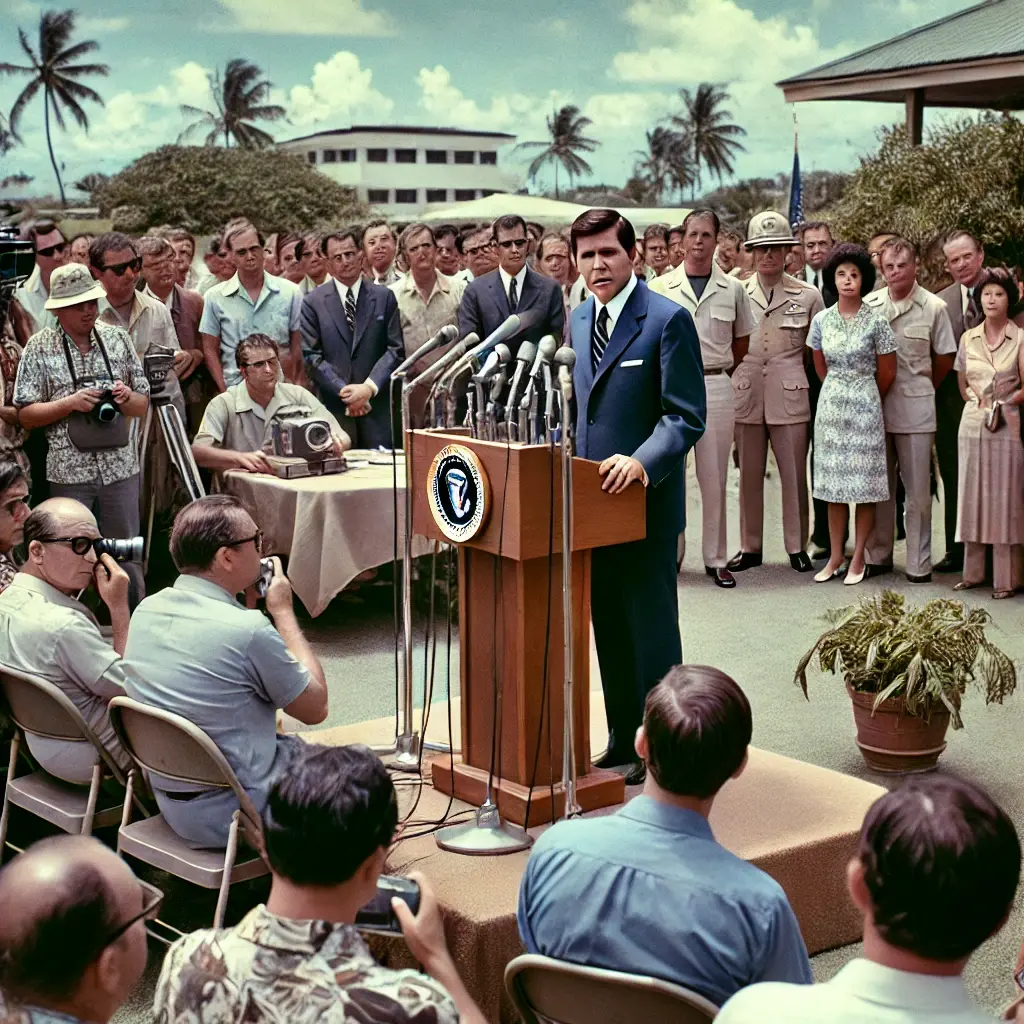President Richard Nixon announced the Nixon Doctrine on July 25, 1969, during a press conference in Guam. This policy stated that the United States would honor its existing defense commitments but that in the future, countries would have to fight their own wars without the support of American troops. The doctrine was intended to reshape U.S. military strategy regarding its involvement in the Vietnam War and reflected a strategic pivot towards empowering allies to defend themselves with American support, rather than direct military intervention.

President Richard Nixon’s announcement of the Nixon Doctrine in 1969 marked a significant shift in American foreign policy. The doctrine emerged during a period of intense debate and growing discontent over the United States’ involvement in the Vietnam War. By this time, the war had dragged on for years, with mounting casualties and no clear end in sight, leading to widespread anti-war sentiment across the United States.
The Nixon Doctrine was rooted in the concept of “Vietnamization,” a strategy aimed at transferring the responsibility of the war effort from American forces to the South Vietnamese. Nixon’s objective was to reduce American troop presence while still providing financial and military support to ensure that South Vietnam could continue to resist North Vietnamese forces. This approach was seen as a way to honor existing commitments without further entangling the U.S. in prolonged conflicts.
Nixon articulated the doctrine during an informal press briefing in Guam, a location symbolizing America’s strategic presence in the Asia-Pacific region. He emphasized that the United States would uphold its treaty obligations but would expect its allies to take on more significant roles in their own defense. This principle of self-reliance was intended to prevent future situations where the U.S. would bear the brunt of military engagements in distant lands.
The doctrine reflected a broader reassessment of U.S. foreign policy in the wake of the Cold War’s evolving dynamics. The American public and policymakers were increasingly questioning the sustainability of maintaining a global military presence. The economic costs and human toll of such interventions were becoming more apparent, leading to calls for a more measured and strategic approach to international conflicts.
One of the critical elements of the Nixon Doctrine was its emphasis on strengthening alliances and partnerships. Nixon and his national security advisor, Henry Kissinger, sought to build a network of capable and self-sufficient allies who could act as regional stabilizers. This policy aimed to contain the spread of communism without direct American military involvement, thereby aligning with the broader goals of containment during the Cold War.
The implementation of the Nixon Doctrine had immediate implications for the Vietnam War. The U.S. began a gradual withdrawal of troops, coupled with increased military aid and training for South Vietnamese forces. Despite initial successes in building up the South Vietnamese military, the long-term effectiveness of Vietnamization remained a contentious issue, as the eventual fall of Saigon in 1975 would later demonstrate.
Beyond Vietnam, the Nixon Doctrine influenced U.S. relations with other countries in Asia. In particular, it led to a reevaluation of America’s role in the defense of nations like South Korea and Japan. These countries were encouraged to enhance their own defense capabilities, which included modernizing their military forces and increasing their defense spending. This policy shift also resonated in the Middle East, where the U.S. aimed to bolster key allies like Iran and Saudi Arabia to serve as regional counterweights to Soviet influence.
The Nixon Doctrine also had a significant impact on U.S. defense policy and military strategy. It prompted a reevaluation of military commitments worldwide and encouraged a more selective approach to engagement. The doctrine influenced the development of military doctrines that prioritized mobility, rapid deployment, and support capabilities over large standing forces stationed abroad.
Critics of the Nixon Doctrine argued that it represented a retreat from America’s global responsibilities and could embolden adversaries by signaling a reluctance to intervene militarily. Supporters, however, viewed it as a pragmatic adjustment to the realities of global power dynamics and a necessary step toward reducing the burden on American resources and lives.
In retrospect, the Nixon Doctrine can be seen as an early attempt at what later came to be known as the “Reagan Doctrine,” which emphasized supporting anti-communist insurgencies and governments with material aid rather than direct military intervention. This continuity in strategic thinking highlighted a sustained effort to balance the goals of containing communism with the practical limits of American military power.
The legacy of the Nixon Doctrine is evident in contemporary U.S. foreign policy. The principle of encouraging allies to take more responsibility for their defense remains a cornerstone of American strategy. This approach is evident in U.S. relations with NATO allies, the security architecture in the Asia-Pacific region, and partnerships with countries in the Middle East and Africa.
Nixon’s articulation of the doctrine also reflected broader changes in international relations. The era of bipolarity defined by U.S.-Soviet rivalry was giving way to a more multipolar world, where regional powers played increasingly significant roles. The Nixon Doctrine acknowledged this shift and sought to adapt American foreign policy to the emerging global order.

Ultimately, the Nixon Doctrine represented a pragmatic response to the challenges of the time. It sought to reconcile the need for global engagement with the realities of domestic constraints and changing international dynamics. While its immediate outcomes were mixed, the doctrine’s emphasis on partnership, burden-sharing, and strategic prudence continues to influence American foreign policy to this day.
